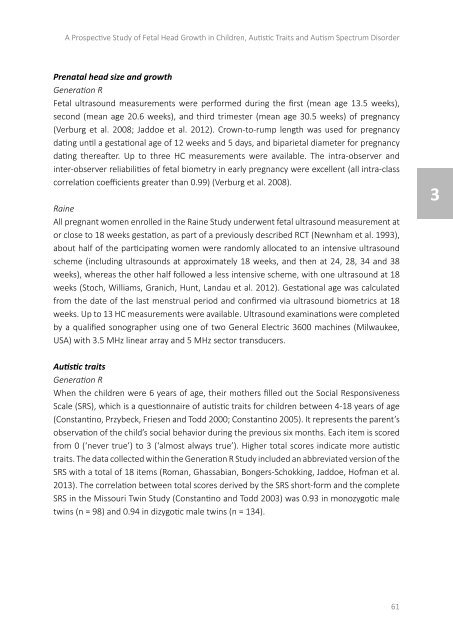On the Spectrum
2lm5UyR
2lm5UyR
Create successful ePaper yourself
Turn your PDF publications into a flip-book with our unique Google optimized e-Paper software.
A Prospective Study of Fetal Head Growth in Children, Autistic Traits and Autism <strong>Spectrum</strong> Disorder<br />
Prenatal head size and growth<br />
Generation R<br />
Fetal ultrasound measurements were performed during <strong>the</strong> first (mean age 13.5 weeks),<br />
second (mean age 20.6 weeks), and third trimester (mean age 30.5 weeks) of pregnancy<br />
(Verburg et al. 2008; Jaddoe et al. 2012). Crown-to-rump length was used for pregnancy<br />
dating until a gestational age of 12 weeks and 5 days, and biparietal diameter for pregnancy<br />
dating <strong>the</strong>reafter. Up to three HC measurements were available. The intra-observer and<br />
inter-observer reliabilities of fetal biometry in early pregnancy were excellent (all intra-class<br />
correlation coefficients greater than 0.99) (Verburg et al. 2008).<br />
Raine<br />
All pregnant women enrolled in <strong>the</strong> Raine Study underwent fetal ultrasound measurement at<br />
or close to 18 weeks gestation, as part of a previously described RCT (Newnham et al. 1993),<br />
about half of <strong>the</strong> participating women were randomly allocated to an intensive ultrasound<br />
scheme (including ultrasounds at approximately 18 weeks, and <strong>the</strong>n at 24, 28, 34 and 38<br />
weeks), whereas <strong>the</strong> o<strong>the</strong>r half followed a less intensive scheme, with one ultrasound at 18<br />
weeks (Stoch, Williams, Granich, Hunt, Landau et al. 2012). Gestational age was calculated<br />
from <strong>the</strong> date of <strong>the</strong> last menstrual period and confirmed via ultrasound biometrics at 18<br />
weeks. Up to 13 HC measurements were available. Ultrasound examinations were completed<br />
by a qualified sonographer using one of two General Electric 3600 machines (Milwaukee,<br />
USA) with 3.5 MHz linear array and 5 MHz sector transducers.<br />
3<br />
Autistic traits<br />
Generation R<br />
When <strong>the</strong> children were 6 years of age, <strong>the</strong>ir mo<strong>the</strong>rs filled out <strong>the</strong> Social Responsiveness<br />
Scale (SRS), which is a questionnaire of autistic traits for children between 4-18 years of age<br />
(Constantino, Przybeck, Friesen and Todd 2000; Constantino 2005). It represents <strong>the</strong> parent’s<br />
observation of <strong>the</strong> child’s social behavior during <strong>the</strong> previous six months. Each item is scored<br />
from 0 (‘never true’) to 3 (‘almost always true’). Higher total scores indicate more autistic<br />
traits. The data collected within <strong>the</strong> Generation R Study included an abbreviated version of <strong>the</strong><br />
SRS with a total of 18 items (Roman, Ghassabian, Bongers-Schokking, Jaddoe, Hofman et al.<br />
2013). The correlation between total scores derived by <strong>the</strong> SRS short-form and <strong>the</strong> complete<br />
SRS in <strong>the</strong> Missouri Twin Study (Constantino and Todd 2003) was 0.93 in monozygotic male<br />
twins (n = 98) and 0.94 in dizygotic male twins (n = 134).<br />
61


